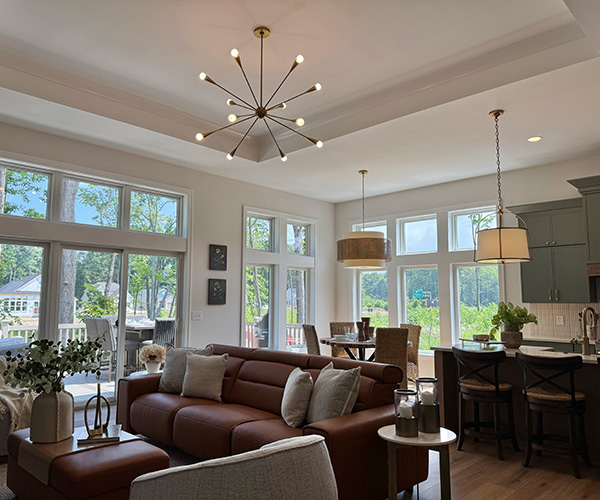In 2001, Calvin Booth was a third-year NBA player for the Seattle SuperSonics. He'd just signed a free-agent contract in the offseason, but the second-round draft pick had injured his ankle just before the season began and was being treated at the Cleveland Clinic. So to escape the hospital, Calvin and his wife, Keisha, would take long drives westward along the lake.
Like many professional athletes, Calvin spent much of his season on the road. Wouldn't it be nice, they mused, to have a home base, a place where they could put down roots — and in a friendly Midwestern community right on the lake?
Keisha had grown up shuttling between New York and the Bahamas. She had been around water her whole life. Calvin's family lived in Columbus, only a two-hour drive away. So a lakeside house in Cleveland made sense.
Calvin and Keisha purchased two adjacent lakefront homes in Avon Lake and promptly knocked both down. Then they started scribbling down their vision for a new, custom-designed home.
"I wanted luxury, high-end," says Keisha, who swooned for the French eclectic style, an in-ground outdoor pool and polished, high-lacquered kitchen cabinets. Calvin's wish list was smaller: He wanted the home to have a basketball court with a regulation 3-point line where he and his children could shoot hoops together.
Although they didn't have kids at the time, they planned for a big family and now have four children.
They wanted self-contained bedrooms with attached bathrooms, so the kids wouldn't have to fight over shower time, and two master suites. "We never intended to move," Keisha explains. "We envisioned transitioning into the lower suite when the kids got older."
Also important in the architectural rendering was height. Calvin, who once blocked 140 shots in a season at Penn State University, is 7-feet tall. "Every place he ever lived, he had to duck," says Keisha. "I never wanted him to deal with that in our home."
Hence, everything from the ceiling height to the countertops to the Jacuzzi bath are sized to fit someone his size. "I made Calvin drive all the way down to [the showroom] just to sit in the tub and see if he could bend his knees in it," laughs Keisha. "I really wanted the bathroom to feel like a retreat for him."
In the master bathroom, everything from the counters to the shower stall to the floors are carved out of a white-gray Carrara marble. The inspiration came from a hotel stay at the Four Seasons in Hawaii years ago. "I saw this beautiful marble on the bathroom," recalls Keisha. So when she met with Cleveland Granite and Marble to pick out materials, "I saw the Carrara marble and I said, 'That's exactly what I want.' "
The 11,000-square-foot, seven-bedroom home took almost two years to build. When it was completed, the basement included a half-court basketball court, a movie theater, an exercise and game room, and a locker room that doubles as a spare bedroom with a Murphy bed, lockers and a bathroom with a urinal. Calvin, who played 10 seasons in the NBA, still has many former-athlete friends. "Some of them like to wake up in the middle of the night and shoot hoops," Keisha explains.
With the house on the lake, the Booths wanted to take full advantage of sunrises and sunsets. The rear-facing windows, made out of plated glass, are larger than standard size and allow panoramic views of the lake and downtown. "The cool thing is that on the Fourth of July, you don't have to go outside to see everyone's fireworks," Keisha says.
The Booths thought they'd live in the home forever. But Calvin was offered a front-office job as a scout and director of player programs with the Minnesota Timberwolves. The house is now for sale, listed at $4.6 million.
"It's sad to leave it," admits Keisha, "but families should be together."
Court Sense
From an engineering standpoint, the 1,400-square-foot basement-level basketball court presented a challenge. "You can't use the same sort of walls you'd use in a typical home," says architect Stephen Schill. "When you're deep into the ground, there's too much lateral pressure." Instead, builders used steel-reinforced poured concrete like in bridge construction. At 20 feet below ground level, rock and shale are prevalent. And while there were no logistical problems, "excavating shale is time-consuming and excessive," Schill says. When the court was finally finished and inlaid with a Penn State logo, Calvin was ecstatic. So was Keisha but for different reasons. "We're down so low that if there was ever a tornado watch, I knew we'd be safe," she laughs.



